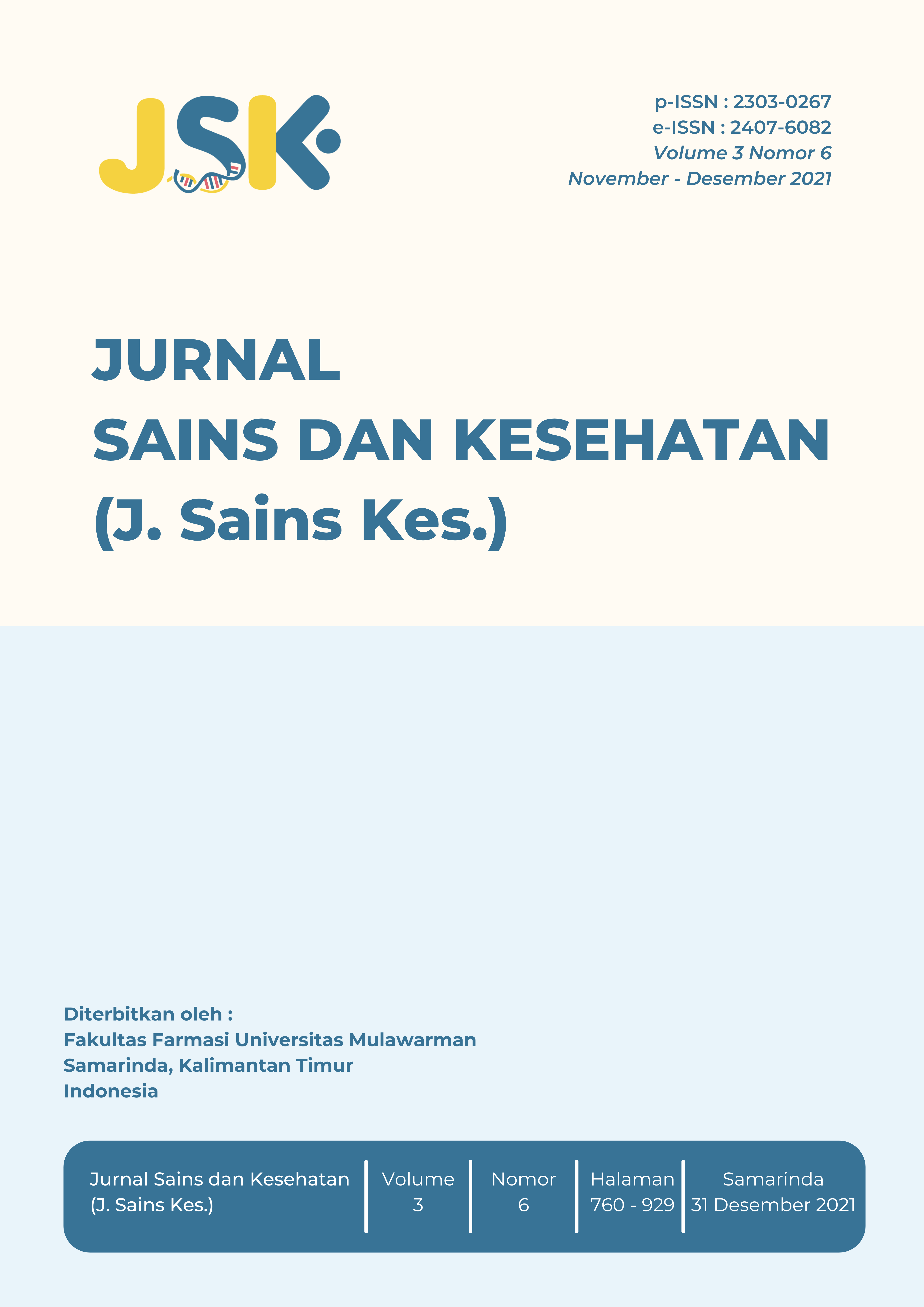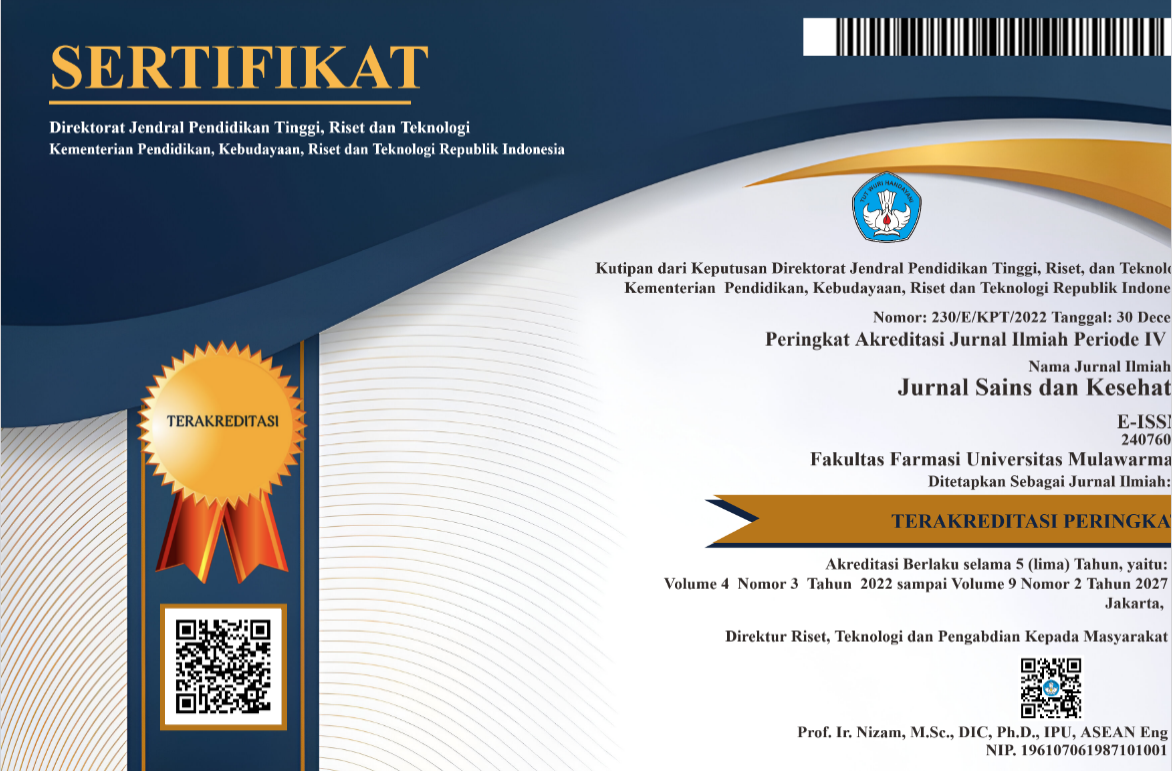Bioaktivitas Ekstrak Etanol Biji Pinang (Arecha catechu L.) terhadap Staphylococcus aureus dan Escherichia coli
Keywords:
biji pinang, daya hambat, E. coli, S. aureusAbstract
References
[1] Salehi, B., Konovalov, D.A., Fru, P. 2020. Areca catechu-from farm to food and biomedical applications. Phytother Res. 34.(9).2140-2158.
[2] Rxlist. 2020. Catechu. Diakses tanggal 21 Juli 2020 melalui laman https://www.rxlist.com/catechu/supplements.htm
[3] Hazarika, D., J. and Sood, K. 2015. In vitro antibacterial activity of peptides isolated from Areca catechu Linn. Der Pharmacia Lettre 7.(1).1-7.
[4] Nurhaida, Usman, F., H, dan Tavita, G., E. 2015. Studi etnobotani tumbuhan obat di Dusun Kelampuk Kecamatan Tanah Pinoh Barat Kabupaten Melawi. Jurnal
Hutan Lestari. 3.(4).526 – 537.
[5] Efremila, Wardenaar, E dan Sisillia, L. 2015. Studi etnobotani tumbuhan obat oleh Etnis Suku Dayak di Desa Kayu Tanam Kecamatan Mandor Kabupaten
Landak. Jurnal Hutan Lestari. 3.(2).234 – 246.
[6] Essien, E., Antia, B., and Etuk, E., I. 2017. Phytoconstituents, antioxidant and antimicrobial activities of Livistona chinensis (Jacquin), Saribus rotundifolius
(Lam.) Blume and Areca catechu Linnaeus Nuts. UK Journal of Pharmaceutical and Biosciences. 5.(1).59 - 67.
[7] Djohari, M., Putri, W., Y., dan Pratiwi, E. 2019. Isolasi dan Uji Aktivitas Daya Hambat Ekstrak Etanol Biji Pinang (Areca catechu L.) Terhadap Bakteri Pada Lidah.
Jurnal Riset Kefarmasian Indonesia. 1.(3). 177-188
[8] Baiti, M., Elrifda, S., dan Lipinwati, L. 2018. Pengaruh pemberian ekstrak etanol biji buah pinang (Areca catechu L.) terhadap pertumbuhan Staphylococus
aureus secara in vitro. JMJ. 6.(1). 10 – 19.
[9] Rajamani, R., Kuppusamy, K., S., Shanmugavadivu, M. and Devadass. 2016. Preliminary phytochemical screening of aqueous extract of Betel Nut and.
International Journal of Biosciense and nanoscience. 3.(1).14-18.
[10] Globinmed. 2020. Areca catechu (L) diakses tanggal 22 Juli 2020 diakses dihttps://www.globinmed.com/index.php?
option=com_content&view=article&id=106303:areca-catechu-l-106303&catid=209&Itemid=143#p12
[11] Ona, W., dan Pongtiku, A. 2016. Buku Tumbuhan Kerarifan Lokal Papua /Papua Traditional Medicine Herbs. Dinas Kesehatan Provinsi Papua. Publikasi
https://www.researchgate.net/publication/321758871.
[12] Amudhan, S., Begum, H., V., and Hebbar, K., B. 2012. A review on phytochemical and pharmacological potential of areca catechuL. Seed. Int J Pharm Sci Res. 3.
(11). 4151- 4157.
[13] Anthikat, R.,R.,N., Michael, A., Kinsalin, V.,A. and Ignacimuthu, S. 2014. Antifungal activity of Areca catechu L. International Journal of Pharmaceutical and
Clinical Science. 4.(1).1-3.
[14] Anthikat, R., R., N. and Michael, A. 2009. Study on the areca nut for its antimicrobial properties. J Young Pharm. 1.(1).42-45.
[15] Rahman, M.,A., Sultana, P., Islam,S., Mahmud, M.,T., Rashid, M.,O. and Hossen, F. 2014. Comparative antimicrobial activity of Areca catechu nut extracts using
different extracting solvents. Bangladesh J Microbiol. 31.(1&2).19-23
[16] Faden, A.,A. 2018. Evaluation of antibacterial activities of aqueous and methanolic extracts of Areca catechu against some opportunistic oral bacteria.
Biosciences Biotechnology Research Asia. 15.(3).655-659
[17] Ramesh, C., H., Mohanraju, R., Kartick, P., and murthy, K., N. 2017. Ef?cacy and effect of Areca catechu nuts. J. Terr. Mar. Res. 1(2).50-53.
[18] Al-Bayati, N., J., M. 2016. In vitro antibacterial and antifungal effect of areca nut extract. Research Journal of Pharmaceutical, Biological and Chemical Sciences,
7.(6).282-286.
[19] Salim, M., Yahya, Sitorus, H., Ni’mah, T., dan Marini. 2016. Hubungan kandungan harah tanah dengan produksi senyawa metabolit sekunder pada tanaman
duku (Lansium domesticum Corr var Duku) dan potensinya sebagai larvasida. Jurnal Vektor Penyakit. 10.(1).11-18.
[20] Sholekha, F,,F. 2017. Perbedaan ketinggian tempat terhadap kandungan flavonoid dan beta karoten buah karika (Carica purbences) daerah Dieng Wonosobo.
Prosiding Seminar Nasional Pendidikan Biologi dan Biologi. Yogyakarta
[21] Xiao, X., Wang, F., Yuan, Y., Liu, J., Liu, Y., Yi, X. 2019. Antibacterial activity and mode of action of dihydromyricetin from Ampelopsis grossedentata leaves
against food-borne bacteria. Molecules. 24. (15). 2831.
[22] Yang, W.,Q., Wang, H.,C., Wang, W.,J.,Wang, Y., Zhang, X.,Q., and Ye, W.,C. 2012. Chemical constituents from the fruits of Areca catechu. Journal of Chinese
Medical Materials. 53.(3).400-403.
[23] Zhang, X., Mei, W., Zeng, Y., and Liu, J. 2009. Phenolic constituents from the fruits of Areca catechu and their antibacterial activities. Journal of Tropical and
Subtropical Botany. 17.(1).74-79.
[24] Ikigai, H., Nakae, T., Hara, Y., Shimamura, T. 1993. Bactericidal catechins damage the lipid bilayer. Biochimica et Biophysica Acta. 1147.(1).132–136.
[25] Chauhan, A., K., Kim, J., Lee, Y., Balasubramaniani, P., K., and Kim, Y. 2019. Isorhamnetin potential for the treatment of Escherichia coli induced sepsis.
Molecules, 24.(21). Doi:10.3390/molecules24213984.
[26] Ren, X., Bao, Y., Zhu, Y., Liu, S., Peng, Z., Zhang, Y. and Zhou, G. 2019. Isorhamnetin, hispidulim and cirsimaritin identified in Tamarix ramasissima barks from
Southern Xinjian and their antioxidant and antimicrobial activities. Molecules. 24.(3).390.Doi: 10.3390/molecules24030390.
[27] Jnawali, H., Jeon, D., Jeong, M., et al. 2016.Antituberculosis activity of a naturally occurring flavonoid, isorhamnetin. J Nat Prod. 79.(4).961-9.
[28] Bhattacharya, D., Ghosh, D., Bhattacharya, S., Sarkar, S., Karmakar, P., Koley, H., Gachhui, R. 2018. Antibacterial activity of polyphenolic fraction of Kombucha
against Vibrio cholerae: Targeting cell membrane, Lett. Appl. Microbiol. 66.(2).145–152, https://doi.org/10.1111/lam.12829.
[29] Habtamu, A, and Melaku, Y. 2018. Antibacterial and antioxidant compounds from the flower extracts of Vernonia amygdalina, Adv. Pharmacol.
Sci.https://doi.org/10.1155/2018/4083736.
[30] Zhang, T. Qiu, Y., Luo, Q., Zhao, L., Yan, X., Ding, Q., Jiang, H., Yang, H. 2018. The mechanism by which luteolin distrips the cytoplasmic membrane of methicillin
resistant Staphylococcus aureus. J.Phys. Chem.B. 122 : 1427-1438.
[31] Lv, P.,C., Li, H.,Q., Xue J.,Y., Shi L., Zhu, H.,L. 2009. Synthesis and biological evaluation of novel luteolin derivatives as antibacterial agents. Eur J Med Chem. 44.
(2).908–914.
[32] Qian, W., Liu, M., Fu, Y., et al. Antimicrobial mechanism of luteolin against Staphylococcus aureus and Listeria monocytogenes and its antibiofilm properties.
Microb Pathogens. 142:.104056. doi:10.1016/j.micpath.2020.104056.
[33] Wang, Q., Xie, M., J. 2010. Antibacterial activity and mechanism of Luteolin on Staphylococcus aureus. Acta Microbiol Sin. 50.(9).1180–1184.
[34] Plaper, A., Golob,M., Bratkovic, I., V., Oblok, M. 2003. Characterization of quercetin binding site on DNA gyrase. Biochemical and Biophysical Research
Communication. 306.(2).530-536
[35] Yang, D., Wang, T., Long, M., Li, P. 2020. Quercetin: Its main pharmacological activity and potential application in clinical medicine. Oxidative medicine and
Celuller Longevity. https://doi.org/10.1155/2020/8825387
[36] Ansari, A., Mahmood, T., Bagga, P., Ahsan, S., Shamim, A., Ahmad, S., Shariq, M., Parveen, S. 2021. Areca catechu: A phytopharmacological legwork. Food
Frontiers. 2.(2).163-183.
[37] Nonaka, G. I., Hsu, F. L., and Nishioka, I. 1981. Structures of dimeric, trimeric, and tetrameric procyanidins from Areca catechu L. Journal of the Chemical
Society, Chemical Communications, (15), 781– 783
[38] Peng, W., Liu, Y., Wu, N., Sun, T., He, X., and Gao, Y. 2015. Areca catechu L.(Arecaceae): A review of its traditional uses, botany, phytochemistry, pharmacology
and toxicology. Journal of Ethnopharmacology. 164. 340- 356.
[39] Wu, M. and Brown, A.,C. 2021. Application of catechins in the treatment of bacterial infections. Pathogens. 10. https://doi.org/10.3390/pathogens10050546
[40] Hoshino, N.,Kimura, T.,Yamaji, A., and Ando, T. 1999. Damage to the cytoplasmicmembrane of Eschericia coli by catechin-copper(II) complexes. Free Radic Biol
Med. 27. 1245-1250
Downloads
Published
Issue
Section
How to Cite
Most read articles by the same author(s)
- Asrianto Asrianto, Suarna Samai, Muhamad Sahidin, Indra Taufik Sahli, Risda Hartati, Wiwiek Mulyani, Efikasi Biolarvasida Berbagai Tanaman Untuk Pengendalian Vektor Nyamuk Anopheles , Jurnal Sains dan Kesehatan: Vol. 5 No. 2 (2023): J. Sains Kes.
Similar Articles
- Herlina Ekapratama Dewi, Rolan Rusli, Welinda Dyah Ayu, Formulasi Krim Antibakteri Fraksi Etil Asetat Daun Kirinyuh (Chromolaena odorata) , Jurnal Sains dan Kesehatan: Vol. 2 No. 2 (2019): J. Sains Kes.
- Asti Vebriyanti Asjur, Karakterisasi Fungi Endofit Syzygium polyanthum (Wight) Walp. Berdasarkan Gen ITS Sebagai Penghasil Senyawa Antibakteri , Jurnal Sains dan Kesehatan: Vol. 3 No. 3 (2021): J. Sains Kes.
- Muh. Nasir, Eri Marwati, Uji Aktivitas Antimikroba Ekstrak Etanol Daging Buah dan Daun Pala (Myristica fragrans) , Jurnal Sains dan Kesehatan: Vol. 4 No. SE-1 (2022): Spesial Edition J. Sains Kes.
- Jessie Elviasari, Rolan Rusli, Adam M. Ramadhan, Identifikasi Metabolit Sekunder Dan Uji Aktivitas Antibakteri Isolat Jamur Endofit Daun Beluntas (Pluchea indica (L.) Less.) , Jurnal Sains dan Kesehatan: Vol. 1 No. 5 (2016): J. Sains Kes.
- Rizka Ahyar Hidayati, Ary Kristijono, Afidatul Muadifah, Uji Aktivitas Antibakteri Sediaan Gel Hand Sanitizer Ekstrak Kulit Buah Jengkol(Archidendron pauciflorum (Benth.) Nielsen) terhadap Bakteri Escherichia coli , Jurnal Sains dan Kesehatan: Vol. 3 No. 2 (2021): J. Sains Kes.
- Dian Fita Lestari, Fatimatuzzahra Fatimatuzzahra, Dwi Dominica, Uji Daya Hambat Bakteri Staphylococcus Aureus Sabun Cuci Tangan Cair Berbahan Arang Aktif Batok Kelapa , Jurnal Sains dan Kesehatan: Vol. 3 No. 2 (2021): J. Sains Kes.
- Nurul Fitriani, Haifa’ Huriyah, Rahmatiyah Rahmatiyah, Optimasi Basis Sediaan Lip Balm dan Uji Aktivitas Antioksidan Ekstrak Biji Pinang (Areca catechu L.) secara In Vitro , Jurnal Sains dan Kesehatan: Vol. 6 No. 2 (2025)
- Eko Kusumawati, Anita Apriliana, Rahmi Yulia , Kemampuan Antibakteri Ekstrak Etanol Daun Nangka (Atrocarpus heterophyllus Lam.) terhadap Escherichia coli , Jurnal Sains dan Kesehatan: Vol. 1 No. 7 (2017): J. Sains Kes.
- Ririn Putri Fani, Masriani Masriani, Dewi Setiya Ningsih, Heni Erliani, Hand Sanitizer Ekstrak Etanol Daun Simpur (Dillenia suffruticosa) sebagai Antiseptik Bakteri Escherechia coli dan Staphilococcus aureus , Jurnal Sains dan Kesehatan: Vol. 5 No. 3 (2023): J. Sains Kes.
- Nurhidayati Febriana, Fajar Prasetya, Arsyik Ibrahim, Aktivitas Antimikroba Ekstrak Daun Bungur (Langerstroemia speciosa (L.) Pers) , Jurnal Sains dan Kesehatan: Vol. 1 No. 2 (2015): J. Sains Kes.
You may also start an advanced similarity search for this article.




